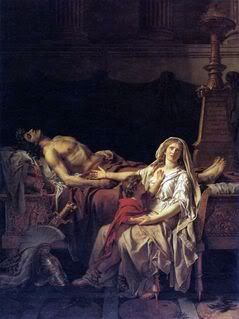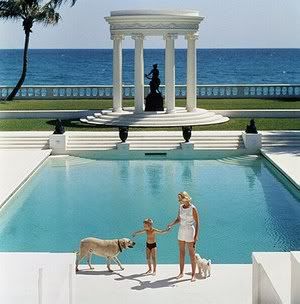What is it that makes us pick up a bottle and anoint ourselves with its jus tentatively in the first place? The inviting colour, the presentation, the name, the brand imbued in history, the luring advertising? For me and
Miracle Forever it was surely the beautiful colour of the bottle. Cradled in a simple architectural glass vessel of intense rosy-tinged purple
Lancôme’s latest offspring will surely catch the eye. Justifiably so.
Lancôme is no stranger to perfumery. In fact its founder Armand Petijean, a Frenchman who had been François Coty’s student, started his company in 1935. While vacationing in the French countryside, Armand Petitjean happened upon a castle ruin that intrigued him- Le château de Lancôme. Inspired by the delicate, fragrant roses which grew among the weathered stones he went on to choose the rose as the symbol of his new company because he believed rose encapsulated the feminine beauty of a woman, hoping to bring the same beauty he experienced into the lives of all women.
Or so the legend goes. There is some controversy to the issue and out of a pure journalistic and historic point of interest I set out to see if this is true. Especially as Lancôme shouldn't necessarily be written with an
accent circumflex. Armand Petitjean was looking for a name that sounded typically French like Vendôme or Brantôme. It was one of his assistants that came up with the idea of "Lancosme" (in which the "s" is not pronounced) - the name of a château in the Indre region of France. This impressed Petitjean and the spelling was eventually changed. The circumflex now perched above the "o" is the one that replaced the "s", in an effort to establish the idea of French-ness to the international market and the rose became the symbol of the company, appearing on boxes and in ads ever since.
The debut of the new fangled company was orchestrated with meticulous care and precision. Not one, not two, but five exquisite fragrances were simultaneously launched at the June opening of the Universal Exhibition in Brussels in summer 1935. The scents were
Tendre Nuit, Bocages, Conquete, Kypre and Tropiques. A prize followed for mr. Petitjean’s company.
With his firm now firmly in the center of attention, he went on to produce skincare and makeup with great success, coming to the US in the 50s, attaching the company’s name to prestige and luxury from France for women everywhere. The line-up would then be joined by the immaculate oriental
Magie.
Nearly all the bottles for the company’s scents were created by the great artist Georges Delhomme and they are today collectors' items. The Fish-Moon bottle for the eau de cologne
Cachet Bleu (1935) is especially celebrated while the bottle with the engraved jasmine in bloom could contain different fragrances. The sensually shaped amphora of
Marrakech brought out in 1947 today commands astronomical prices.
Envol coming out in 1957 combines rose and jasmine, and the bottle, with its original bud-vase shaped design, is complete with a rosebud cap.
In 1969
Ô, a fresh eau de toilette full of petitgrain and lemony tones with a tenacious sandalwood base that prevents it from fleeting into thin air was introduced in a frosted bottle with designs like a 60s wallpaper. Very pop-art and it soon firmly became a favourite for many people who embraced its fresh breeze in an era ripe for revolt and change, to hell with the old. This was followed in 1987 by
Ô Intense, a now defunct offering that supposedly made the cologne more in tune with the heavier atmosphere of the carnal 80s, based as it was on rose absolute, a heavy attar. The
accent circumflex is again redundant, but it entered the name in an effort to consolidate the spirit of Lancôme to the comsumer’s mind, a subtle move of great cunning, copied also in
Ô for Men, another discontinued item, since the original was secretly used by many discerning males anyway. The last flanker to join this line was
Ô Oui ! in 1998, and this one has stayed the course, but to me it is hardly related to the original, as it is bursting with aqueous fruits, in which melon is predominant, on a base of eunuch-innocent musks and has none of the crystalline transparency of its older sister.
Meanwhile the great
Sikkim was launched in 1971, a rich fragrance enriched with Bulgarian rose and jasmine combination on a base worthy of a Caron perfume. Today
Sikkim is sold exclusively at the Lancôme Institute: 29, rue du Faubourg Saint Honoré - 75008 PARIS
Not to bypass the completely elegant floral chypre named
Climat that aromatized the 70s with its aura of infinite grace and romance , the men’s
Sagamore with the intense woody character of a bygone era or the dark oriental “parfum fourrure” (fur coat perfume, as the French call these) brilliantly baptised
Magie Noire (Black magic) of deep incensy rose with disturbing amber and labdanum.
It was the year 1990 that saw the great bestseller of the brand,
Trésor, a quite heavy-handed but soft, powdery, fruity composition by nose Sophia Grojsman, allying rose with peach in a formula that in fact relies mainly in 4 ingredients: Hedione (a synthetic jasmine), methyl ionone (a sweet fruity aroma), Iso E Super (a woody synthetic), and Galaxolide (a synthetic musk). The winning combination proved uber-successful to the point of asphyxia in many a european elevator during the early nineties.
The same intense fruitiness with the former -and the intentional spelling accident appearing in
Ô- persisted in
Poême in 1996. Fronted by the gorgeous, vulnerable looking French actress Juliette Binoche this was a mega-launch that was accompanied by verse by Baudelaire and Hugo for a fragrance that relied on an overdose of what appears to be orange blossom in clotted cassis (a fruity synthetic berry base). The sledgehammer sweetness dictates an extremely light application of this one.
The limited time window of the seasonal offering
Mille et une rose to celebrate the millenium, which left hundreds of fans of its wonderful ambery rose tunes crestfallen when it got discontinued, has been recently amended by the introduction of
2001 Roses which is to be a mainstay, along with
Sikkik,
Climat and
Magie in a Collection with limited distribution at select stores.
Miracle was added in 2000 with the face of Uma Thurman and the motto “Lancôme believes in miracles and magic” and
Miracle Forever is joining the fairytale as a flanker now. Apart from the original
Miracle, there is also
Miracle Summer (2004 Limited edition),
Miracle So Magic (2004) and
Miracle Ultra Pink (2005), not to mention the male version
Miracle Homme. As all these fragrances (the women’s at least) are more or less simple florals with varying degrees of depth so a woody oriental permutation was needed to clinch the deal and bring
Miracle into the whirlwind of today’s taste for the sweet and patchouli-rich aromas of women’s perfumes. Of course one might argue that this segment has already been filled in Lancôme by
Attraction (a not so successful attempt at an orientalised sensual perfume inspired by Angel) and the truly too recent
Hypnôse (2005, another take on the gourmand patchouli orientalia of Angel).
Miracle Forever begins its fragrant journey on the weirdly spicy trip of star anise, the fragrant star-shaped fruit of
Illicium anisatum, coupled with the sweetness of blackcurrant as if someone has spiked a kir royal cocktail with a pinch of a Chinese culinary aroma. The touch of the aromatic makes for an interesting beginning that is not completely out of synch with the light energising ginger accord of the original
Miracle, although that one culminated in a floralncy that was less sweet and more airy.
The heart is floral with peony and white florals of which tuberose is listed, yet does not make its presence known to my nose. Instead the almond blossom which featured also in Yves Saint Laurent’s
Cinema and in Kenzo
Amour recently, lends a little powdery touch in alliance with the heliotrope spectrum, while the whole culminates in the rich patchouli swirls of fancy that fan out vanilla and amber in copious amounts, restrained only by a tad of cedar in the background making it last long. The overall sweetness differentiates it from the more woody, albeit similar in construction
Allure Sensuelle by Chanel, making it more intense and more in your face. I think this is its greatest fault and the reason some will find it too much. If one genuinely likes the recent variations on the sweet patchouli fragrances, like Armani
Code,
MontBlanc Femme,
Euphoria by Calvin Klein or indeed
Hypnôse,
Miracle Forever won’t disappoint. For the rest it is a case of a slight déjà vu.
Miracle Forever comes in an Eau de Parfum concentration in 30ml/1oz , 50ml/1.7oz and 75ml/2.5oz and the ads feature brunette beauty Shallom Harlow. It has already launched in Europe this fall, while it will launch in the US in 2007.
Pic of bottle from Perfumemart, ad for Envol courtesy of Okadi.

.jpg)









